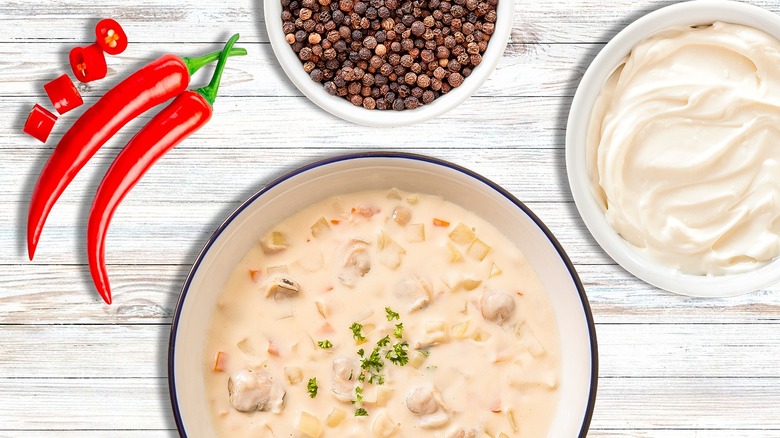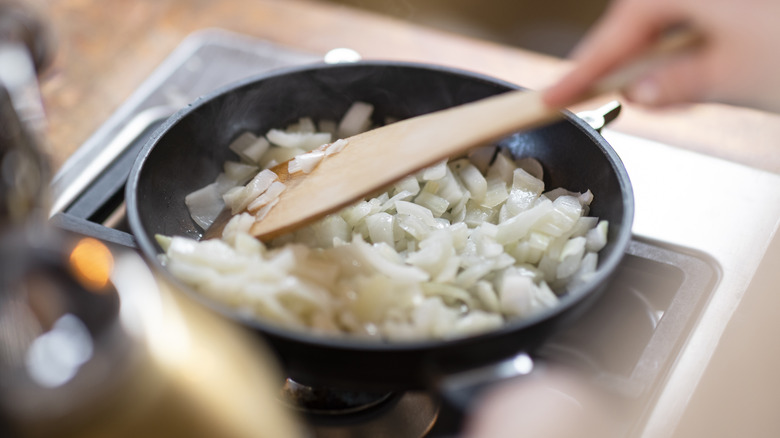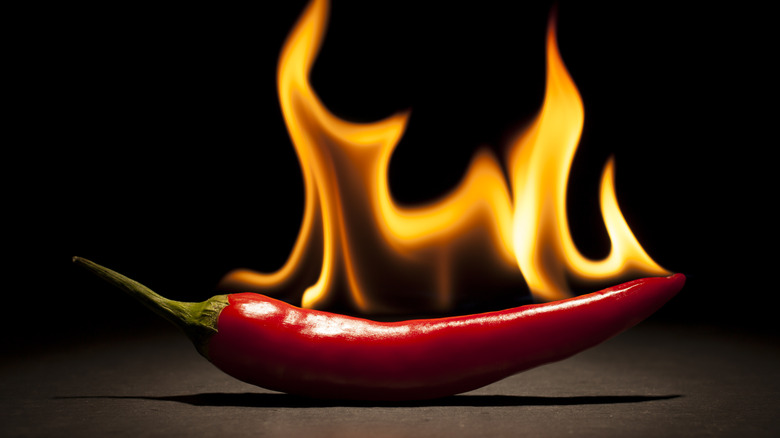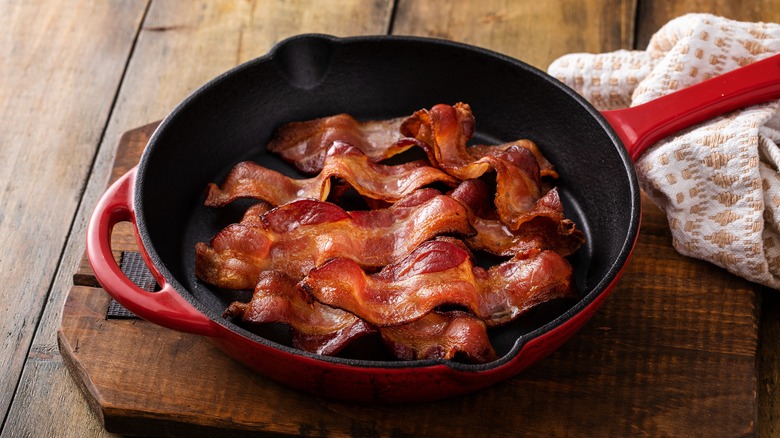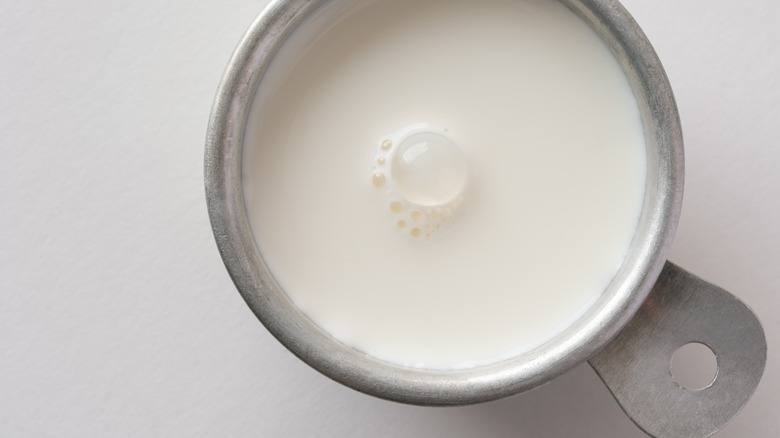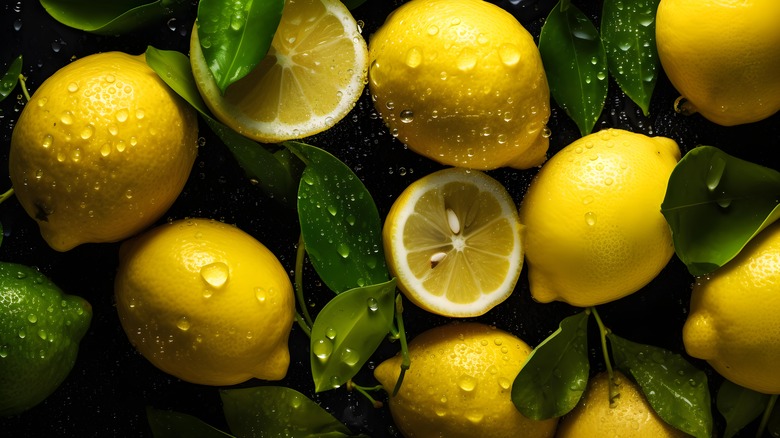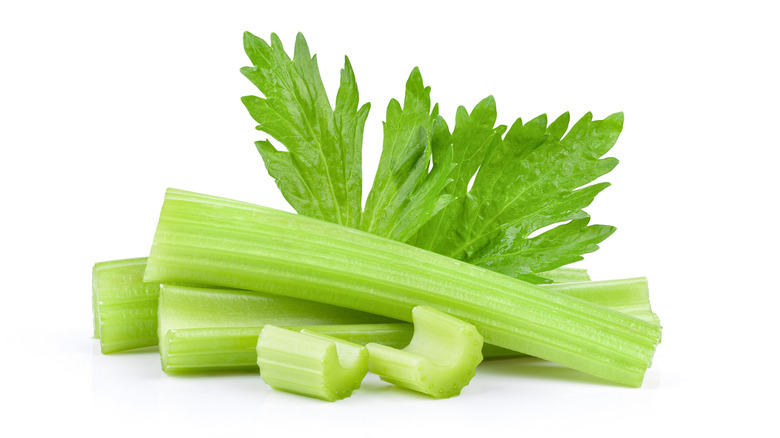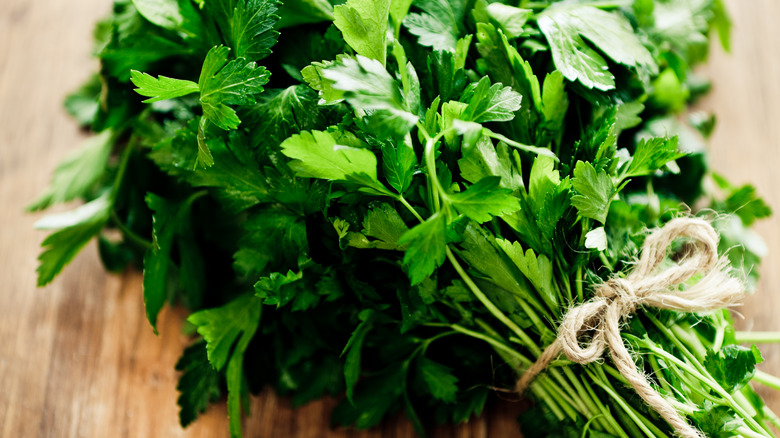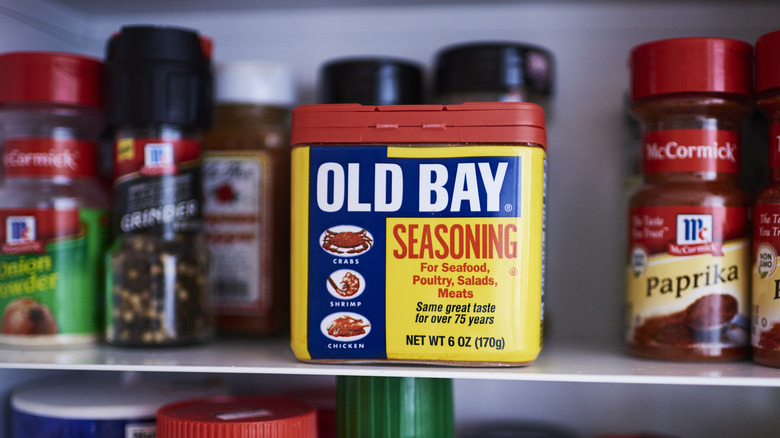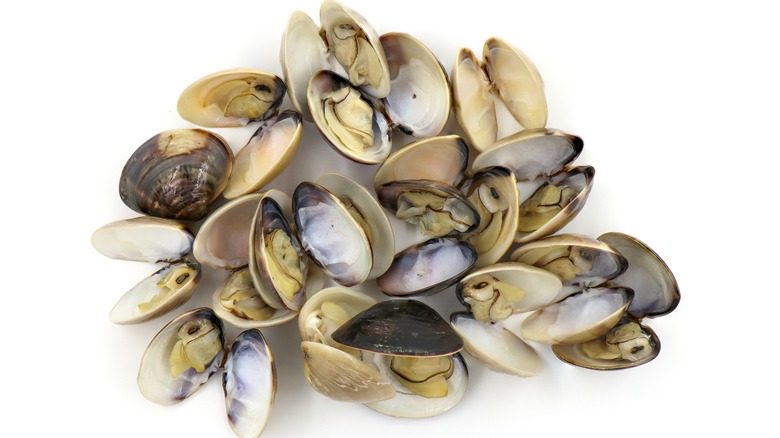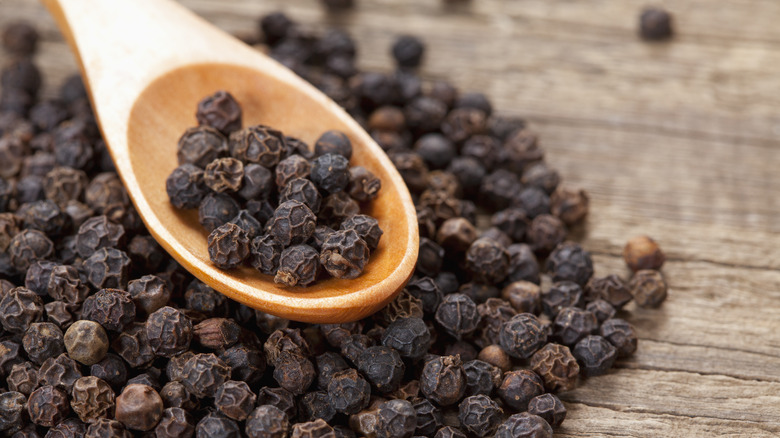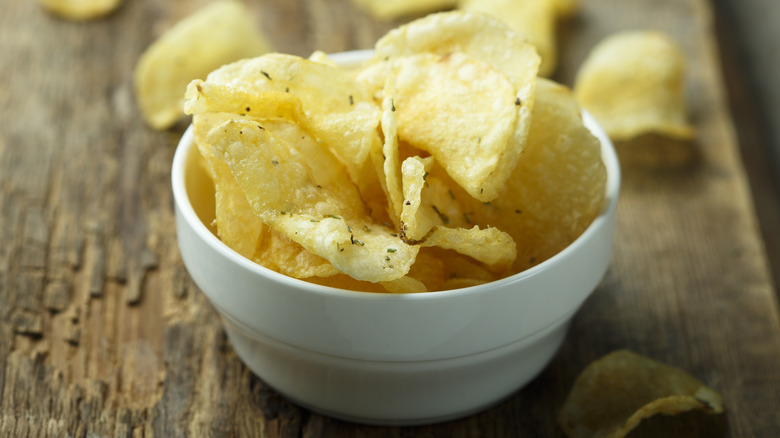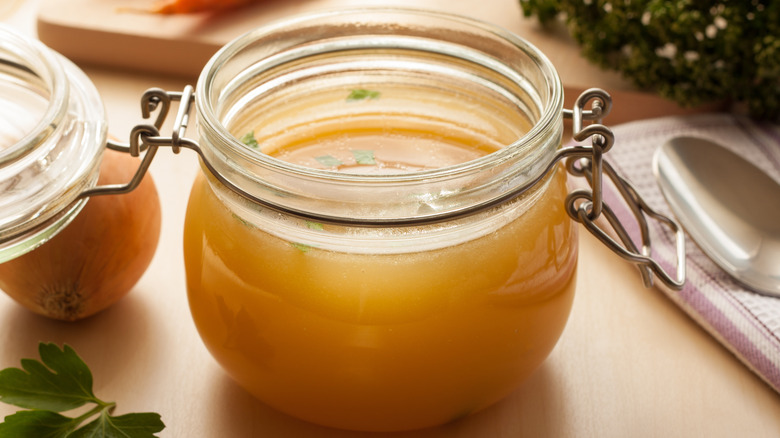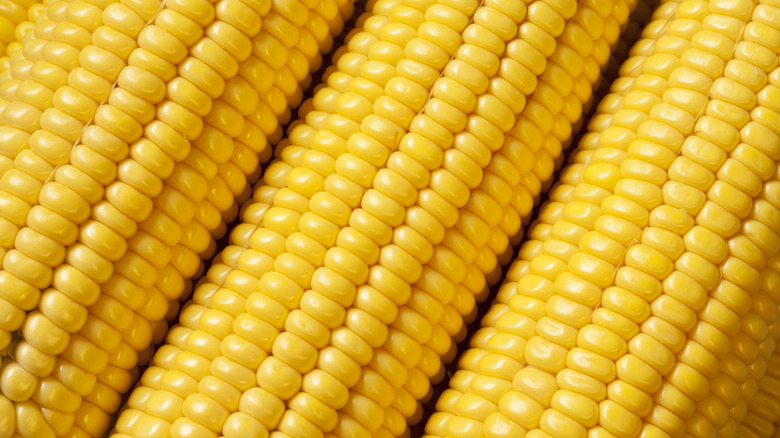14 Ingredients To Add Flavor To Canned Clam Chowder
Canned clam chowder is a perfect convenience food. It's super-easy to prepare — just heat and eat — and it feels like a hearty meal when served with some hot bread or rolls. However, canned chowder isn't always the most exciting dinner. This robust, starch-thickened, dairy-laden soup can taste a bit flat. Especially if you eat it regularly, you might crave some variety.
Fortunately, the same neutrality that makes canned chowder feel a little blah also means it's the perfect blank slate for any number of creative add-ins. From extra meats to additional vegetables to a variety of herbs and spices, there are countless ways to transform canned chowder from a utilitarian mainstay to a crave-worthy treat. If you want the best possible chowder experience without actually making it from scratch, this list of extra ingredients and add-ins won't lead you astray. And rather than just picking one tip, you can mix and match multiple of these ingredients to create the loaded chowder of your dreams.
1. Sauteed alliums
The shortcut to making anything taste good is sizzling some onions and garlic in oil, and canned clam chowder is no exception. Sauteed alliums (onions, garlic, and other related vegetables) will add complexity, savoriness, and sweetness to your canned soup, lending it just a touch of homemade flavor.
The onion-and-garlic combo is classic, but it's not the only option. Try using leeks for a French take on clam chowder — just remember to wash them thoroughly as they can be filled with grit. Shallots are another great choice for a refined, European accent; they almost taste like mild onions with a hint of garlic flavor. Switching up the fat you saute with gives you a lot of customizability as well. Olive oil will add a bit of bitterness and some fruity notes, while butter will reinforce the creamy dairy flavor that's already present in the chowder. For the perfect hit of salty smokiness, cook your alliums in bacon fat.
Regardless of what allium and fat combination you prefer, make sure to cook it long enough to soften the vegetables before adding them to the chowder. Most people won't enjoy crunchy bits of raw onion or garlic in their soup.
2. Chiles
Canned clam chowder is undeniably decadent, rich, and creamy, but it can lack balance — it's good to add pungent, sharp, or acidic ingredients to cut through the thick broth and wake up your palate. That's where chiles come in. How exactly you incorporate the heat comes down to how much effort you want to put in; the simplest way to amp up the capsaicin content of your chowder is to sprinkle some chile flakes or cayenne on your bowl and call it a day.
If you're feeling a little more enterprising, chop up a fresh chile and mix it with your soup. The specific pepper choice is up to you and your heat tolerance. On the milder end, poblanos or jalapeños will lend a touch of spice along with some earthy vegetal flavors. If you're a spice fiend, habañeros or Scotch bonnets will turn up the flames while contributing some tropical sweetness and acidity. If raw peppers aren't your thing, saute them in your cooking oil of choice instead of (or in addition to) chopped alliums before mixing with your chowder. Whatever route you choose, mince the peppers finely so they blend well with the soup — you don't want one bite to be mild and the next to knock your head off.
3. Bacon or ham
Instead of trying to temper the creaminess of the chowder with zesty ingredients, you can lean in and double down on rich flavors. Recipes for homemade clam chowder frequently contain some kind of smoked, cured pork, but you won't find this ingredient in many brands of canned clam chowder, including Campbell's. That's a shame because chunks of ham or bacon go a long way in terms of adding complexity, savoriness, and unctuous fattiness to the dish. Fortunately, it's easy to throw some pork in as a last-minute addition.
If you're using ham, you can simply dice it and add it into the pot as you're heating your chowder, though it will be more flavorful if you take the time to sear your meat before adding it to the soup. For bacon, you want to cut it into small pieces and crisp it up in a pan — chunks of flabby bacon floating in chowder aren't anybody's idea of appetizing. In addition to adding delicious Maillard browned flavors, pre-frying the bacon will render much of its fat. It's a good idea to drain off most of this rendered bacon fat before combining the bacon with the chowder to avoid making a greasy mess. After crisping, you can either cook the bacon in the chowder for a couple of minutes or sprinkle it on top as a garnish to preserve its texture.
4. Cream
Cream is another great way to make canned chowder feel more luxurious. Although the tinned soup has a creamy mouthfeel and a white color, it can tend to be light on actual dairy. Not to pick on Campbell's again, but the ingredient list for the brand's Chunky New England Clam Chowder shows that none of the milk ingredients make up more than 2% of the volume of the product. The thick texture is the result of various starches and thickeners rather than dairy. This is very different from homemade chowder, which often uses a large portion of milk or cream.
Mixing your canned chowder with cream helps to make up for the missing milkfat. If you're starting with condensed soup, replace some of the water with cream when you're diluting it to serve. For non-condensed products, simply mix a tablespoon or two into the hot chowder before serving. If you want a lighter option, use evaporated milk instead of cream.
5. Citrus
The scarcity of real dairy in certain brands of canned clam chowder is helpful if you're hoping to add citrus for some bright flavor. That's because adding acidic ingredients like citrus juice to milk causes its casein protein to form clumps, a phenomenon known as "curdling." This is great if you're making ricotta at home, but less than ideal for anyone who doesn't want lumpy, cheesy-tasting chowder. It would be a bad idea to squeeze lemon juice into dairy-rich homemade chowder, but you can probably get away with adding it to most canned chowders. Just check the ingredients to make sure there's not too much milk in the can (Manhattan clam chowder, which is traditionally dairy-free, is always fair game).
Lemon and seafood are always a great pairing; a spritz of citrus juice in your chowder will enhance all the other flavors in the soup with its mouthwatering acidity. If you have good reason to be afraid that the chowder will curdle, don't worry: There's still a way to incorporate the freshness of citrus. Instead of squeezing in some juice, garnish your bowl with grated citrus rind. This will perfume your soup with the aroma of the fruit without contributing dangerous acidity.
6. Celery
Like bacon and cream, celery is a traditional clam chowder ingredient that may be missing (or at least barely present) in some canned versions of the soup. There might just be some celery flavoring in the broth or a few sad, soft chunks of the vegetable. This is easy to remedy at home by finely chopping some fresh celery and incorporating it into your chowder.
As with the alliums, it's a good idea to saute the celery before mixing it with the canned soup. While it's nice for this vegetable to retain a bit of crispness to lend your chowder some textural interest, you don't want it to be distractingly raw and crunchy, either. Sauteing it will break it down more than simply boiling it in the broth would.
The fresh celery will be a major upgrade over whatever came in the can — it will add a savory pop and some brightness.
7. Herbs
Garnishing your bowl of chowder with fresh herbs will not only make it taste better but also enhance its aesthetic appeal — specks of green will break up the beige mush of the soup. It's an easy customization, too; just chop up your herb of choice and add it right when you're serving.
Different herbs will take your chowder in very different directions. If you don't want to upset the balance of flavors, some curly parsley will lend some mild grassiness but won't take over. On the more assertive end of the spectrum, tarragon's anise-like flavor goes great with creamy dishes like chowder. Thyme's mild woodiness is another great fit.
Other herbs that will take chowder to the next level are oniony ones like chives and scallion tops. Sliced thinly and scattered on top of the soup, these will provide an allium punch without having to dice and saute a regular onion. Make sure you have a sharp knife for slicing the herbs so you preserve their color and don't bruise them.
8. Fish sauce
Manipulating acidity, saltiness, and heat are all obvious ways to improve canned clam chowder, but there's another dimension of flavor that's worth just as much attention — umami. Adding umami-rich ingredients to your chowder will increase its savoriness, meatiness, and overall deliciousness. You have many to choose from, but fish sauce makes a ton of sense to add to chowder specifically. Fish sauce is an umami bomb that also has some sweetness, which works well with the sweet dairy notes of chowder. It also tastes like fish (duh), which would strengthen and harmonize with the clam flavor in the soup.
If you don't like fish sauce or just don't have it in your pantry, other umami boosters will work too. Soy sauce would be delicious, though it will darken the color of the broth. MSG is basically pure powdered umami, so it will increase the chowder's savoriness without changing any other flavors. Parmesan cheese would be an interesting addition as long as you're okay with mixing cheese and seafood.
9. Old Bay
The pride of Baltimore, Maryland, Old Bay seasoning has been livening up steamed crabs and all other kinds of seafood since 1940. This mysterious secret blend of celery salt, paprika, and as many as 16 other spices is the perfect seasoning to pep up canned clam chowder. It's such an obvious home run that Campbell's even makes a version of its Chunky Clam Chowder that's pre-seasoned with Old Bay.
If you don't happen to have that particular can in your pantry, you'll have to sprinkle on your own Old Bay, which isn't so hard — the only thing you really have to worry about is sodium. In addition to delivering a mild kick of heat, some mustardy sharpness, and sweet floral notes, Old Bay is very salty. Start with just a little shake to make sure you don't end up ruining your bowl of chowder (or raising your blood pressure) with excessive salt. If you really want to commit to the crab boil flavor profile, you could even add some picked crabmeat to the chowder along with the Old Bay.
10. More clams
This might seem kind of silly since there are already clams in canned chowder, but their sweet seafood brininess can sometimes get drowned out by the starchy broth they're floating in. If you find that the canned chowder in your pantry isn't delivering on clam flavor, why not just add more clams?
The easiest (and most likely cheapest) way to accomplish this is to buy canned clams. They taste surprisingly great, and all you have to do is open the can, dump the contents into your soup, and heat until everything is warm.
You can also steam, shuck, and chop your own fresh clams and mix them with your chowder, but at that point, you're already spending so much time in the kitchen that you might be better served making chowder from scratch. However, even when served with canned chowder, fresh clams will be undeniably delicious — if you do decide to go this route, make sure to use the liquid that comes out of the clams as they cook, because it's packed with flavor.
11. Black pepper
Sometimes the simplest add-ins can make the biggest difference. In terms of effort-to-reward ratio, nothing on this list can hold a candle to black pepper. With its nose-clearing sharpness and bitter floral notes, it has some of the same effects as chiles or citrus in terms of cutting through the stodginess of chowder and making your tongue pay attention, but with almost no work. All it takes is a few twists of a pepper grinder.
And we do emphasize that you should be using a grinder to add fresh pepper to your chowder. The boxed stuff may be okay in some contexts, but it won't cut it here — it lacks the punch and complexity of freshly ground pepper. This isn't a dish where the pepper is going to be a background note. Canned clam chowder is mild and neutral enough that the taste of pepper will be highlighted, so this isn't the time to use pepper out a shaker that vaguely tastes like old cardboard.
12. Potato chips
Clam chowder, especially the canned kind, can be a bit texturally monotonous. Garnishing it with something crispy makes for a more enjoyable eating experience, and no garnish combines craveable flavor with a satisfying texture like potato chips.
Chowder usually contains potatoes, so by topping it with potato chips, you're reinforcing flavors already present in the dish. You'll want sturdy chips that won't sog out immediately when exposed to hot broth (thick-cut kettle-cooked brands are perfect for this purpose). Crush them into small enough pieces that are easy to pick up with a spoon, but don't go overboard and make chip dust. Sprinkle them on right before serving to maintain their crisp texture.
Plain chips are the safest choice, but there's room to experiment here. Salt and vinegar chips would bring some acidity, while sour cream and onion would deliver a hit of allium pungency. Combining two of our suggestions by using Old Bay chips would be amazing.
13. Stock/bouillon
This add-in is particularly helpful if you're looking for a flavorful liquid substitution for diluting condensed soup. Any kind of stock is going to be a flavor upgrade over plain water. If you want to amp up the clam flavor of your chowder without adding more chunks of seafood, clam juice is pretty easy to find in most supermarkets. Boxed fish stock would add a similar flavor. Alternatively, you could increase the savoriness of the dish by mixing in some chicken or pork stock. The one type of broth you might want to stay away from is beef; its potent taste might detract from the other flavors in the soup, and its dark color might make the chowder look muddy.
If you don't keep boxed stock around, you may be able to use bouillon instead. However, you need to be careful not to make the chowder too salty if you go this route. Check how much sodium your preferred brand of soup has and adjust accordingly.
14. Corn
By adding corn to your canned clam chowder, you're essentially creating a hybrid of the two most popular types of chowder. This is a can't-miss mix-in, as the mildly sweet taste of corn harmonizes perfectly with the dairy notes of the soup without distracting too much from the clams.
Of course, corn tastes best when it's in season and cut straight off of the cob, but that's a lot of effort to put in to dress up a convenience food like canned clam chowder. Frozen corn is sweet all year round and usually has a nice crisp texture, and all you have to do to incorporate it is thaw it in the hot soup. Even canned corn isn't a bad option if you need to use entirely shelf-stable ingredients. It tastes good, but the mouthfeel will be softer than fresh or frozen corn. You might want to stay away from canned creamed corn, however — it's just too mushy.
